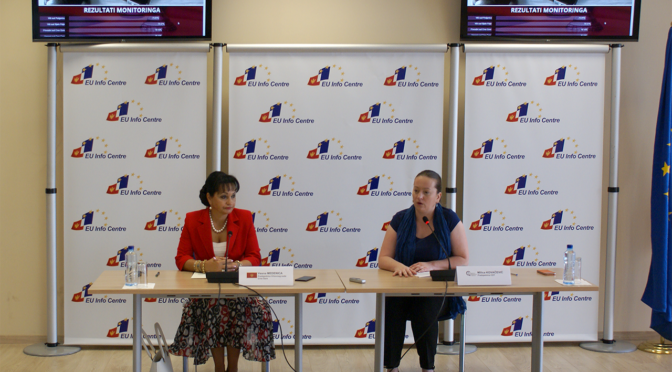Courts’ transparency in Montenegro is doubled comparing to 2014 while Judicial Council has improved it for 20%, shows recent research conducted by Center for Democratic Transition – CDT.
Transparency and openness of the judicial authorities is of particular importance for public trust in judicial system, especially having in mind that researches show that the majority of citizens of Montenegro does not have confidence in courts.
In addition, by providing full transparency an important role is achieved in raising public confidence and education, improving access to justice, and increasing courts accountability.
Dissatisfied with the results of transparency of Montenegrin courts, which in 2014 were 41 %, CDT, two years ago, addressed to courts specific recommendations. Through joint actions we worked to improve the situation.
In June and July 2016, through the project “Initiative for Open Judiciary “, funded by EU, CDT has decided to repeat the monitoring and check whether there has been progress.
METHODOLOGY
Comparing to 2014, we used more strict criteria and introduced some new transparency requirements.
We assessed 15 Basic, 2 High, the Appellate, and the Supreme Court. We also included for the first time Administrative and Commercial courts.
Transparency of the courts was measured with 30 performance indicators, which are divided into 4 areas: transparency of organizational information, accessibility, integrity, efficiency.
Performance indicators relating to prevention of conflict of interests, monitoring and evaluation of work were included as well.
Data were collected through the analysis of the regulations governing the work of judicial institutions and individual acts of courts, detailed search and analysis of official websites of the courts and the analysis of responses to questionnaires sent to all courts.
Judicial Council has been the subject of a separate analysis and it was assessed on the basis of 63 specific indicators of performance.
RESULTS:
The most transparent among the courts are the Supreme Court of Montenegro and the Basic Court Niksic (they met 90% of indicators), while the lowest score has Basic Court Cetinje (it met 71 % of indicators).
More details are available at: www.infosud.me
All courts in Montenegro have websites with functional search engine.
All courts included in the research have published on their websites the most important administrative documents – the scope of work, organizational structure, biographies of judges, as well as a list of civil servants with positions. Also, court decision are published regularly.
However, 11 courts do not regularly update website with press releases and information about their current work.
Although they inform media with press releases and respond to their demands for information they rarely or not at all organize press conferences in order to inform public.
Only three courts have a large courtroom, while most have room for 15-30 interested citizens. On the other hand, the answers from the questionnaire showed that even nine courts are not accessible for people with disabilities.
BUDGET TRANSPARENCY
The judiciary budget for 2015 amounts to 20.8 million euros, which is about 200 thousand more than in the previous year. However, the largest part of the budget, approximately 78% is spent on wages (as stated in EC report), which means that the allocated funds are not sufficient.
Budget transparency of the judicial system in the last two years significantly improved through the publication of information on budget expenditure in the annual reports.
However, the Judicial Council does not publish the courts’ budget for the current year, which is a serious drawback in the field of budget transparency.
Also, budget information are an integral part of Judicial Council annual report and they are not specifically stated on the website which makes them difficult to find.
JUDICAL COUNCIL
Comparing to 2014 when only half of determined criteria were met, this research showed that that Judicial Council improved its transparency (76 %).
Although the most of information are published on the website they are hard to find – hidden in the statements and sections of the website which would not be checked logically and intuitively.
At Judicial Council webpage, during the monitoring period, a list of officials and their salaries and other incomes was not published which is contrary to the Law on Free Access to Information.
The Judicial Council in its submitted reply to the questionnaire informed us that a spokesperson of the Secretariat of the Judicial Council was appointed.
However, in the contact section of the website, name and surname and contacts of spokesperson can be found. Available is only general e-mail address which can be an obstacle for communication with the media.
CONCLUSION
Based on precisely determined conditions and recommendations, CDT will, through various activities and cooperation with judicial institutions, continue to work on improvement of transparency and openness of the courts and their communication with the public.



